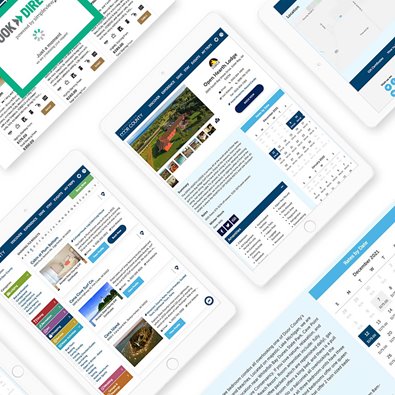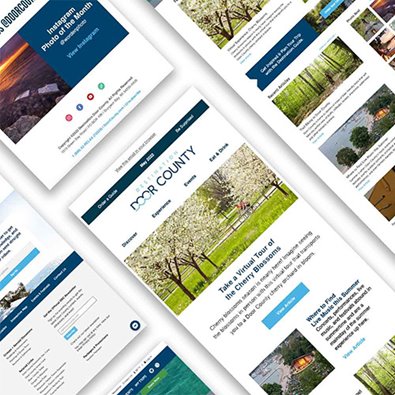If you're in travel and tourism, you know that a destination marketer's job is never done. At the center of all travel-centric content is powerful storytelling.
However, to truly connect with potential travelers and inspire action, a DMO website must provide all of the on-demand details that could help dreamers book and plan their next getaway.
After you have invested in stunning professional photography and videography, you'll want to turn to the technical aspect of your website; its speed, capacity, and functionality.
Top 4 technical features that drive travel-centric conversions
1. Plenty of (SEO-Friendly) Content
One of the biggest mistakes small and medium-sized DMOs make is not providing enough useful and actionable content about travel activities, lodgings, or attractions.
Not only do you need to list out the many activities your destination offers, but you also need to provide the audience with specifics that empower them to take action and encourage them to spend their money at local businesses.
For example:
Say your location is known for mountain biking.
- What’s the overall experience like, and how does it differ from other destinations’ biking experiences?
- Where are the specific parks, forests, or trails where cyclists can go to enjoy this activity?
- Do visitors need permits or licenses?
- Are there special regulations to follow or fees to pay?
- Is there a trail map to refer to?
- Can mountain bikes be rented at any local businesses?
- Where’s a good place for a post-ride coffee or beer?
A little SEO keyword research can go a long way toward understanding which activities your audience is most interested in (that is, which content pages to have) and what information about these activities they seek (what kinds of information to include on the page). Plus, you can use these search terms and key phrases within the actual copy/content to help users find your website and discover your destination.
Pro Tip: As Search marketing continues to evolve, be sure to include related terms in your multimedia metadata, which will now be ranked higher in the SERP.
2. An easy-to-use booking engine
At the end of the day, for most DMOs, "heads in beds" is the one proper way of measuring the success of a tourism system.
There's no way around the fact that cold, hard reservations for lodging, dining, activities, and services are how money flows into local businesses and supports the destination at large.
Make it easy for users to find, compare, and book reservations and experiences directly through your website or through a third-party integration that tracks the customer's digital journey (so your website gets the traffic attribution).
Be sure the booking tool is easy to find or even a persistent feature so users can book a room, meal, or activity when they are ready to commit.
Though you're moving people towards a booking engine, travel guides, PDFs, and booklets will always serve as a conversion win while visitors are considering travel opportunities.
Pro Tip: Invest in an interactive PDF that will allow users to circle back directly to your website. Linking a 'book now' button from a static travel guide back to the booking engine allows travelers to book faster and with fewer distractions once they have made their decision.
3. Interactive tools and experiences
Once users have reached your website you need to help them get to know your destination. Do this with digital tools that help them plan the actual trip and interactive experiences that help them understand what it feels (or tastes, smells, looks, etc.) to be there.
Well-written, descriptive content that’s specific, detailed, and sensory-driven is a great start. But take it one step further with interactive
- Maps and guides
- Itinerary-building tools
- Virtual experiences
- Video content
- Games
- Immersive interfaces
- Quizzes or “finders”
Or anything else that enables users to act, react, or interact with your website and help solidify their mental connection to your destination.
Opportunities include:
- Showcase a detailed directory of all area businesses, events, and partners
- Build an interactive map of local Burroughs and communities that includes real-time weather and a best of list
- Include a personalized trip planner, based on season, type of lodging, types of activities, and trip style
- Create a database of local events and seasonal festivals
- Publicize sustainability efforts with an economic pledge
- Leverage Google tools with an interactive map that can filter by lodging type, dining, recreation, art, shopping, services, and activities
- Build packages and experience showcases by traveler type; For those with families, history buffs, those seeking culture, culinary lovers, eco-enthusiasts, outdoor adventurers, pet-friendly destinations, those focused on relaxation or travels looking for the weird, haunted or unusual
- Leverage local hot spots and business partners to create art exhibits, foodie tours, about-town bingo, and more
Pro tip: It's vital to add interactive and gamified features as you can to drive potential visitors towards reservation and booking details. But you must lead with user experience (UX). You don't want to overwhelm. It's important to space out these features based on age, and where it can be best leveraged within the research process.
4. Reliable analytical intelligence
It's time to talk about data. It's vital that all of your website, marketing, and booking efforts are tracked across channels. Once your business hat is on, you need to identify the top numbers that truly impact your community. Once you have those identified, you will want to be sure that Google Analytics, tag manager, your business profiles, related business pages, and all community partners pages have the right UTM and affiliated tracking data so your core team can truly identify booking trends.
In a quick recap:
- Awareness is created through a brand of traffic and engagement
- Economic impact is measured by tracking downloads, offers, and clicks
- Revenue can be justified by tracking your average night and booking ratios
In many cases, specialized destination marketing agencies and DMO-centric CMSs have created pay walls to their custom dashboards. However, these custom dashboards can also be easily created within Google Analytics 4, without the added overhead.
Metrics that matter:
- Visitor origin
- Top destinations
- Visitors by market
- Economic Impact (Visitors vs spend)
- Average night stay by hotel
However, it's about analysis, not analytics. Not all analytics are created equally. Make sure your data is meaningful, and let it drive change.
Yes, of course, you need imagery
Let's circle back to visual communications. This may seem like a no-brainer, but in noisy tourism industry with countless destinations publishing a never-ending stream of photos, videos, and user-generated content on social media, beautiful images of your destination that evoke feelings of elation, novelty, and wanderlust are an absolute must-have.
Vibrant, clear, and aspirational photography—including landscape shots, drone shots, people-oriented shots, athletic shots, and action shots—will be well worth the investment when you use this media on your website, emails, social channels, print materials, and business communications.
Pro Tip: If your photography budget is on the lower side, consider crowdsourcing local imagery on social media, from professional contacts, or local businesses and organizations.
Most of the time, people are thrilled to have their photos reach a wider audience, especially when they get photo credit or attribution.
[Bonus] Don’t forget a reliable publishing outlet
A monthly newsletter, a biweekly blog, a frequently updated News and Events page, a trove of trip ideas or itineraries, or even just an Instagram feed: in one form or another, you need a way to get the latest activities, offerings, and experiences in front of your audience. You need to both tell and show consumers the fantastic experiences they’re missing out on by not exploring your destination.
Plus, regularly pushing out new content designed to meet users’ search queries and capture other travel-related keywords or phrases is an excellent way to up your site’s SEO game.
If you're a destination marketing organization trying to decide how to level up your digital presence, consider giving our pros a call for a free consultation. We can discuss the differences between travel-centric content management systems and other main stream platforms, and we can chat about the marriage of form and function — destination storytelling and the practical applications that inspire action.



